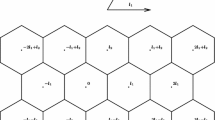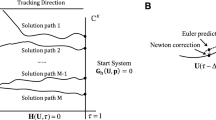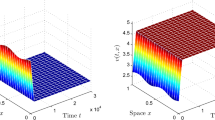Abstract
In this paper, we review analytical methods for a rigorous study of the existence and stability of stationary, multiple spots for reaction–diffusion systems. We will consider two classes of reaction–diffusion systems: activator–inhibitor systems (such as the Gierer–Meinhardt system) and activator–substrate systems (such as the Gray–Scott system or the Schnakenberg model). The main ideas are presented in the context of the Schnakenberg model, and these results are new to the literature. We will consider the systems in a two-dimensional, bounded and smooth domain for small diffusion constant of the activator. Existence of multi-spots is proved using tools from nonlinear functional analysis such as Liapunov–Schmidt reduction and fixed-point theorems. The amplitudes and positions of spots follow from this analysis. Stability is shown in two parts, for eigenvalues of order one and eigenvalues converging to zero, respectively. Eigenvalues of order one are studied by deriving their leading-order asymptotic behavior and reducing the eigenvalue problem to a nonlocal eigenvalue problem (NLEP). A study of the NLEP reveals a condition for the maximal number of stable spots. Eigenvalues converging to zero are investigated using a projection similar to Liapunov–Schmidt reduction and conditions on the positions for stable spots are derived. The Green’s function of the Laplacian plays a central role in the analysis. The results are interpreted in the biological, chemical and ecological contexts. They are confirmed by numerical simulations.
Similar content being viewed by others
References
Benson D.L., Maini P.K. and Sherratt J.A. (1998). Unravelling the Turing bifurcation using spatially varying diffusion coefficients. J. Math. Biol. 37: 381–417
Castets V., Dulos E., Boissonade J. and De Kepper P. (1990). Experimental evidence of a sustained standing Turing-type nonequilibrium chemical pattern. Phys. Rev. Lett. 64: 2953–2956
Crampin E.J., Gaffney E.A. and Maini P.K. (1999). Reaction and diffusion on growing domains: scenarios for robust pattern formation. Bull. Math. Biol. 61: 1093–1120
Crampin, E.J., Gaffney, E.A., Maini, P.K.: Mode doubling and tripling in reaction–diffusion patterns on growing domains: a piece-wise linear model. J. Math. Biol. 44, 107–128, 1093–1120 (1999)
Dancer E.N. (2001). On stability and Hopf bifurcations for chemotaxis systems. Methods Appl. Anal. 8: 245–256
De Kepper P., Castets V., Dulos E. and Boissonade J. (1991). Turing-type chemical pattern in the chlorite-iodide-malonic acid reaction. Phys. D 49: 161–169
Doelman A., Gardner R.A. and Kaper T.J. (2001). Large stable pulse solutions in reaction–diffusion equations. Indiana Univ. Math. J. 50: 443–507
Doelman A., Gardner A. and Kaper T.J. (1998). Stability analysis of singular patterns in the 1-D Gray–Scott model: a matched asymptotic approach. Phys. D 122: 1–36
Doelman, A., Gardner, A., Kaper, T.J.: A stability index analysis of 1-D patterns of the Gray–Scott model. Mem. Am. Math. Soc. 155(737), xii+64 (2002)
Doelman A., Kaper T. and Zegeling P.A. (1997). Pattern formation in the one-dimensional Gray–Scott model. Nonlinearity 10: 523–563
Dufiet V. and Boissonade J. (1992). Conventional and unconventional Turing patterns. J. Chem. Phys. 96: 664–673
Ei S. (2002). The motion of weakly interacting pulses in reaction–diffusion systems. J. Dyn. Diff. Equ. 14: 85–87
Ei S., Nishiura Y. and Ueda K. (2001). 2n splitting or edge splitting: a manner of splitting in dissipative systems. Jpn J. Ind. Appl. Math. 18: 181–205
Fife, P.C.: Stationary patterns for reaction–diffusion systems. In: Nonlinear Diffusion. Research Notes in Math., vol. 14, pp. 81–121. Pitman, London (1977)
Fife P.C. (1979). Large time behaviour of solutions of bistable nonlinear diffusion equations. Arch. Rat. Mech. Anal. 70: 31–46
Gidas B., Ni W.M. and Nirenberg L. (1981). Symmetry of positive solutions of nonlinear elliptic equations in R N. Adv. Math. Suppl. Stud. 7A: 369–402
Gierer A. and Meinhardt H. (1972). A theory of biological pattern formation. Kybernetik (Berlin) 12: 30–39
Gray P. and Scott S.K. (1983). Autocatalytic reactions in the isothermal, continuous stirred tank reactor: isolas and other forms of multistability. Chem. Eng. Sci. 38: 29–43
Gray P. and Scott S.K. (1984). Autocatalytic reactions in the isothermal. continuous stirred tank reactor: oscillations and instabilites to the system A + 2B → 3B, B → C. Chem. Eng. Sci. 39: 1087–1097
Hale J.K., Peletier L.A. and Troy W.C. (2000). Exact homoclinic and heteroclinic solutions of the Gray–Scott model for autocatalysis. SIAM J. Appl. Math. 61: 102–130
Hale J.K., Peletier L.A. and Troy W.C. (1999). Stability and instability of the Gray–Scott model: the case of equal diffusion constants. Appl. Math. Lett. 12: 59–65
Iron D., Wei J. and Winter M. (2004). Stability analysis of Turing patterns generated by the Schnakenberg model. J. Math. Biol. 49: 358–390
Kolokolnikov T. and Ward M.J. (2003). Reduced wave Green’s functions and their effect on the dynamics of a spike for the Gierer–Meinhardt model. Eur. J. Appl. Math. 14: 513–545
Kolokolnikov T. and Ward M.J. (2004). Bifurcation of spike equilibria in the near-shadow Gierer–Meinhardt model. Discret. Contin. Dyn. Syst. Ser. B 4: 1033–1064
Kolokolnikov T., Ward M.J. and Wei J. (2005). The existence and stability of spike equilibria in the one- dimensional Gray–Scott model: the low-feed regime. Stud. Appl. Math. 115: 21–71
Kolokolnikov T., Ward M.J. and Wei J. (2005). The existence and stability of spike equilibria in the one- dimensional Gray–Scott model: the pulse-splitting regime. Phys. D 202: 258–293
Kondo S. and Asai R. (1995). A viable reaction–diffusion wave on the skin of Pomacanthus, a marine Angelfish. Nature 376: 765–768
Koch A.J. and Meinhardt H. (1994). Biological pattern formation from basic mechanisms to complex structures. Rev. Mod. Phys. 66: 1481–1507
Kwong M.K. and Zhang L. (1991). Uniqueness of positive solutions of Δu + f(u) = 0 in an annulus. Diff. Integral Equ. 4: 583–599
Lengyel I. and Epstein I.R. (1991). Modeling of Turing structures in the chlorite-iodide-malonic acid-starch reaction system. Science 251: 650–652
Lee K.J., McCormick W.D., Pearson J.E. and Swinney H.L. (1994). Experimental observation of self- replicating spots in a reaction–diffusion system. Nature 369: 215–218
Lee K.J., McCormick W.D., Ouyang Q. and Swinney H.L. (1993). Pattern formation by interacting chemical fronts. Science 261: 192–194
Levin S.A. (1992). The problem of pattern and scale in ecology. Ecology 73: 1943–1967
Madzvamuse A., Maini P.K. and Wathen A.J. (2005). A moving grid finite element method for the simulation of pattern generation by Turing models on growing domains. J. Sci. Comput. 24: 247–262
Madzvamuse A., Wathen A.J. and Maini P.K. (2003). A moving grid finite element method applied to a model biological pattern generator. J. Comput. Phys. 190: 478–500
Maini P.K., Baker R.E. and Chuong C.M. (2006). The Turing model comes of molecular age. Science 314: 1397–1398
Maini P.K., Painter K.J. and Chau H. (1997). Spatial pattern formation in chemical and biological systems. J. Chem. Soc. Faraday Trans. 93: 3601–3610
Meinhardt H. (1982). Model of Biological Pattern Formation. Academic, London
Meinhardt H. (1995). The Algorithmic Beauty of Sea Shells. Springer, Berlin
Mimura, M.: Reaction–diffusion systems arising in biological and chemical systems: applications of singular limit procedures. In: Mathematical Aspects of Evolving Interfaces (Funchal, 2000). Lecture Notes in Mathematics, vol. 1812. Springer, Berlin (2003)
Muratov C.B. and Osipov V.V. (2000). Static spike autosolitons in the Gray–Scott model. J. Phys. A Math. Gen. 33: 8893–8916
Muratov C.B. and Osipov V.V. (2002). Stability of the static spike autosolitons in the Gray–Scott model. SIAM J. Appl. Math. 62: 1463–1487
Murray J.D. (2003). Mathematical Biology II: Spatial Models and Biomedical Applications, Interdisciplinary Applied Mathematics, vol. 18. Springer, Heidelberg
Ni W.-M. (1998). Diffusion, cross-diffusion and their spike-layer steady-states. Not. Am. Math. Soc. 45: 9–18
Nishiura, Y.: Far-From-Equilibrium-Dynamics, Translations of Mathematical Monographs, vol. 209. AMS publications, Providence, Rhode Island (2002)
Nishiura Y. (1982). Global structure of bifurcating solutions of some reaction–diffusion systems. SIAM J. Math. Anal. 13: 555–593
Nishiura Y. and Fujii H. (1987). Stability of singularly perturbed solutions to systems of reaction–diffusion equations. SIAM J. Math. Anal. 18: 1726–1770
Nishiura Y., Teramoto T. and Ueda K. (2003). Scattering and separators in dissipative systems. Phys. Rev. E 67(5): 56210
Nishiura Y. and Ueyama D. (1999). A skeleton structure of self-replicating dynamics. Phys. D 130: 73–104
Nishiura Y. and Ueyama D. (2001). Spatio-temporal chaos for the Gray–Scott model. Phys. D 150: 137–162
Ouyang Q. and Swinney H.L. (1991). Transition from a uniform state to hexagonal and striped Turing patterns. Nature 352: 610–612
Ouyang Q. and Swinney H.L. (1991). Transition to chemical turbulence. Chaos 1: 411–420
Painter K.J., Maini P.K. and Othmer H.G. (1999). Stripe formation in juvenile pomacanthus explained by a generalized Turing mechanism with chemotaxis. Proc. Nat. Acad. Sci. USA Dev. Biol. 96: 5549–5554
Pearson J.E. (1993). Complex patterns in a simple system. Science 261: 189–192
Pearson J.E. and Horsthemke W. (1989). Turing instabilities with nearly equal diffusion constants. J. Chem. Phys. 90: 1588–1599
Reynolds J., Pearson J. and Ponce-Dawson S. (1994). Dynamics of self-replicating patterns in reaction diffusion systems. Phys. Rev. Lett. 72: 2797–2800
Reynolds J., Pearson J. and Ponce-Dawson S. (1997). Dynamics of self-replicating spots in reaction–diffusion systems. Phys. Rev. E 56: 185–198
Sandstede B. and Scheel A. (2005). Absolute inequalities of standing pulses. Nonlinearity 18: 331–378
Schnakenberg J. (1979). Simple chemical reaction systems with limit cycle behaviour. J. Theor. Biol. 81: 389–400
Segel, L.A., Levin, S.A.: Appliations of nonlinear stability theory to the study of the effects of dispersion on predator–prey interactions. In: Piccirelli, R. (ed.) Selected Topics in Statistical Mechanics and Biophysics. Conference Proceedings no. 27. American Inst. Physics, New York (1976)
Sick S., Reinker S., Timmer J. and Schlake T. (2006). WNT and DKK determine hair follicle spacing through a reaction–diffusion mechanism. Science 314: 1447–1450
Sun W., Ward M.J. and Russell R. (2005). The slow dynamics of two-spike solutions for the Gray–Scott and Gierer–Meinhardt systems: competition and oscillatory instabilities. SIAM J. Appl. Dyn. Sys. 4: 904–953
Takagi I. (1986). Point-condensation for a reaction–diffusion system. J. Diff. Equ. 61: 208–249
Turing A.M. (1952). The chemical basis of morphogenesis. Phil. Trans. R. Soc. Lond. B 237: 37–72
Vastano J.A., Pearson J.E., Horsthemke W. and Swinney H.L. (1987). Chemical pattern formation with equal diffusion coefficients. Phys. Lett. A 124: 320–324
Vastano J.A., Pearson J.E., Horsthemke W. and Swinney H.L. (1988). Turing patterns in an open reactor. J. Chem. Phys. 88: 6175–6181
Ward M.J. (2006). Asymptotic methods for reaction–diffusion systems: past and present. Bull. Math. Biol. 68: 1151–1167
Wei J. (1999). On single interior spike solutions of the Gierer–Meinhardt system: uniqueness and spectrum estimates. Eur. J. Appl. Math. 10: 353–378
Wei J. (1999). Existence, stability and metastability of point condensation patterns generated by Gray–Scott system. Nonlinearity 12: 593–616
Wei J. (2001). Pattern formations in two-dimensional Gray–Scott model: existence of single-spot solutions and their stability. Phys. D 148: 20–48
Ward M.J. and Wei J. (2002). The existence and stability of asymmetric spike patterns for the Schnakenberg model. Stud. Appl. Math. 109: 229–264
Ward M.J. and Wei J. (2003). Hopf bifurcations and oscillatory instabilities of solutions for the one-dimensional Gierer–Meinhardt model. J. Nonlinear Sci. 13: 209–264
Wei J. and Winter M. (1999). On the two-dimensional Gierer–Meinhardt system with strong coupling. SIAM J. Math. Anal. 30: 1241–1263
Wei J. and Winter M. (2000). Spikes for the two-dimensional Gierer–Meinhardt system: the strong coupling case. J. Diff. Equ. 178: 478–518
Wei J. and Winter M. (2001). Spikes for the two-dimensional Gierer–Meinhardt system: the weak coupling case. J. Nonlinear Sci. 11: 415–458
Wei J. and Winter M. (2003). Existence and stability of multiple-spot solutions for the Gray–Scott model in \(\mathbb {R}^ 2\) Phys D 176: 147–180
Wei J. and Winter M. (2003). Asymmetric spotty patterns for the Gray–Scott model in R 2. Stud. Appl. Math. 110: 63–102
Author information
Authors and Affiliations
Corresponding author
Rights and permissions
About this article
Cite this article
Wei, J., Winter, M. Stationary multiple spots for reaction–diffusion systems. J. Math. Biol. 57, 53–89 (2008). https://doi.org/10.1007/s00285-007-0146-y
Received:
Revised:
Published:
Issue Date:
DOI: https://doi.org/10.1007/s00285-007-0146-y




